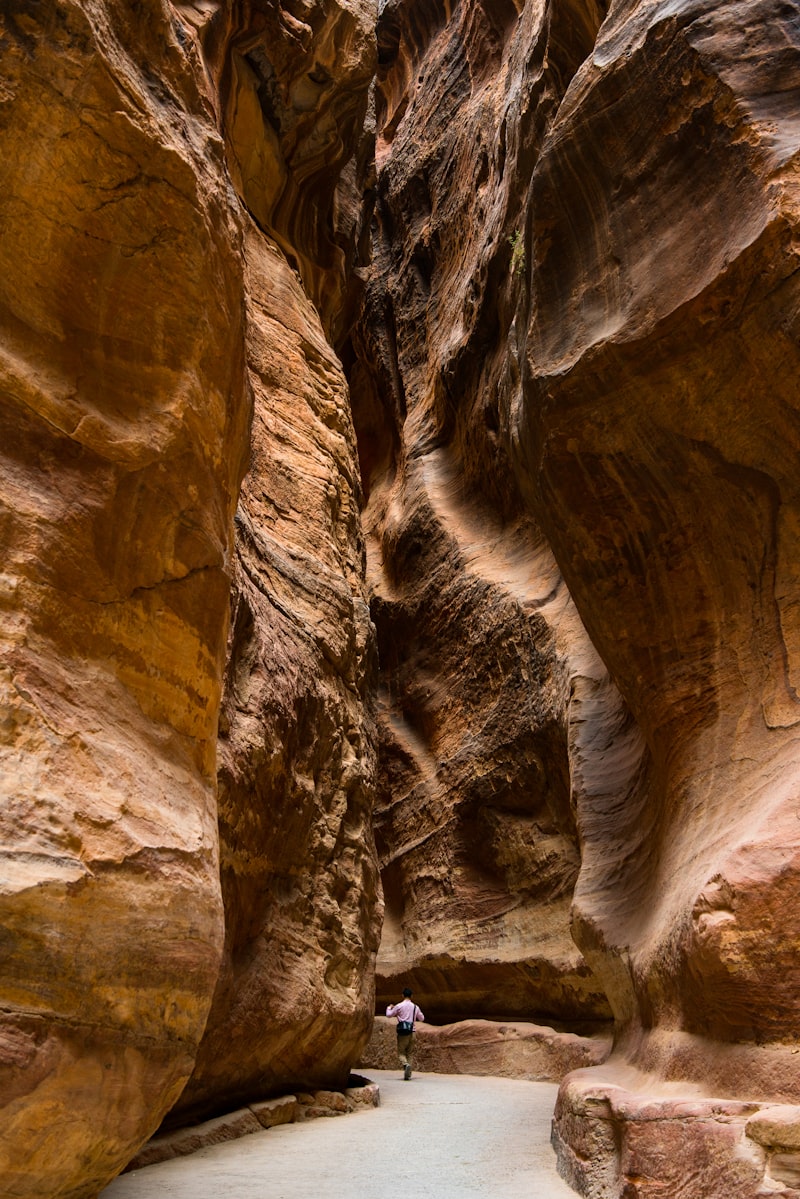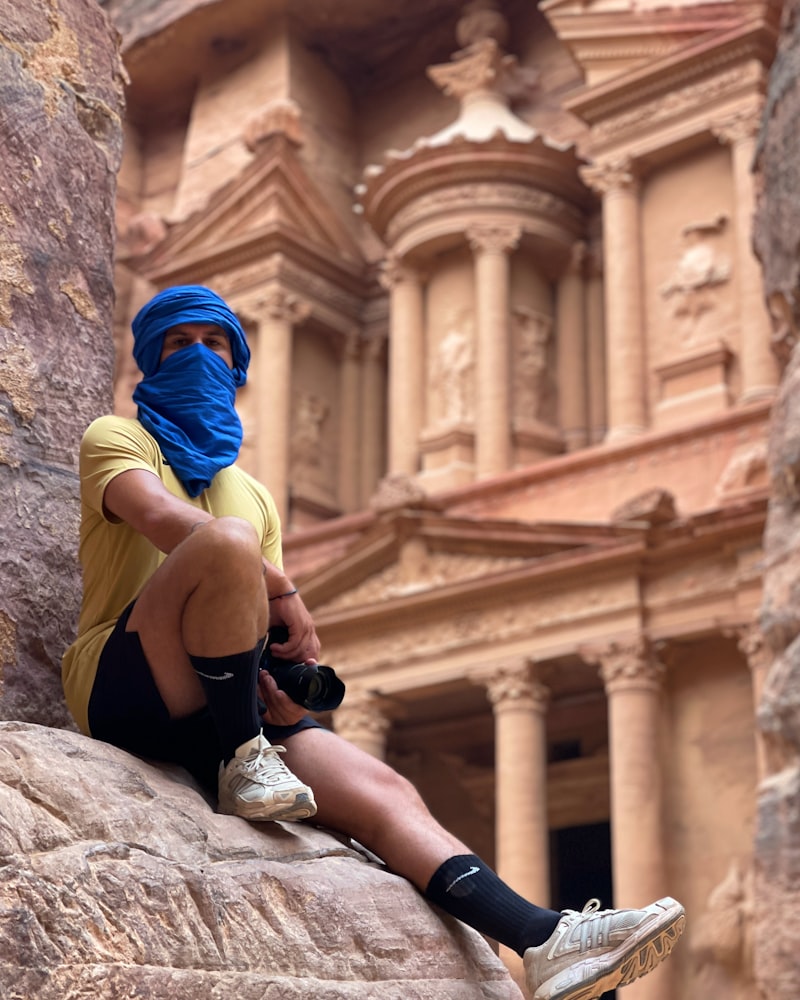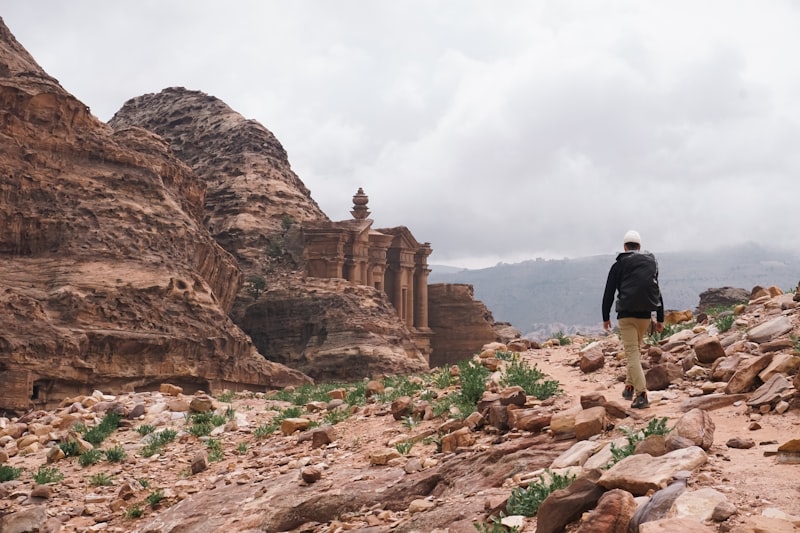Imagine stepping into a realm frozen in time, where colossal sandstone cliffs guard secrets etched by ancient civilizations. Petra, nestled in the rugged terrain of modern-day Jordan, stands as a testament to human ingenuity and craftsmanship. Carved into pink-hued rock faces, this UNESCO World Heritage site beckons travelers with its awe-inspiring architecture and storied past.
At its heart lies the iconic Treasury, Al-Khazneh, a breathtaking facade chiseled into the cliffside. Legend has it that this majestic structure once housed treasures of unimaginable wealth, drawing explorers and historians alike to unravel its mysteries. The intricate details of its columns and statues, bathed in the desert sun, evoke a sense of wonder and reverence.
Beyond the Treasury, a labyrinth of tombs, temples, and amphitheaters unfolds, each bearing witness to Petra’s former glory as a thriving Nabataean city. The Monastery, another marvel of ancient engineering, rewards those who venture further into the rocky terrain with its grandeur and panoramic views of the surrounding landscape.
Visiting Petra is not just a journey through history but a glimpse into the resilience of a people who carved a thriving city amidst harsh desert conditions. The Siq, a narrow canyon path leading to the Treasury, adds to the allure, its towering walls creating a dramatic entrance that builds anticipation with every step.

Today, Petra stands as a symbol of cultural heritage and a testament to the artistic prowess of its creators. As you wander through its ancient corridors and marvel at its intricate rock-cut architecture, you can’t help but be transported back in time, imagining the bustling markets, religious ceremonies, and daily life that once animated these stone walls.
In every corner of Petra, from the majestic facades to the humble dwellings, the past whispers its tales, inviting visitors to unravel its secrets and appreciate the legacy left behind by the Nabataeans.
Unveiling Petra: Exploring Jordan’s Hidden Jewel of Antiquity
Imagine walking through a narrow gorge, the famous Siq, with towering cliffs on either side, as if nature herself carved a path to this hidden gem. As you emerge from the Siq, you’re greeted by the iconic sight of Al-Khazneh, or the Treasury, a magnificent facade intricately carved into the sandstone rock face. This marvel, believed to be a mausoleum, showcases the advanced engineering and artistic skills of the Nabataeans, who built Petra as their capital city around 300 BCE.
Beyond the Treasury, Petra unfolds into a vast archaeological site, revealing a city that thrived as a crucial junction for trade routes linking ancient Mesopotamia, Egypt, and southern Arabia. The Nabataeans, skilled traders and artisans, created a thriving metropolis with temples, tombs, theaters, and residential quarters, all ingeniously carved into the pink sandstone cliffs.
Each step through Petra is a journey through time, offering glimpses into a civilization that mastered water conservation with its intricate system of dams, cisterns, and channels. The Roman influence, following their annexation of Petra in 106 CE, added further architectural elements, blending seamlessly with Nabataean craftsmanship.
Today, Petra continues to captivate visitors with its grandeur and mystique, drawing adventurers, historians, and archaeologists alike. Whether exploring the imposing Monastery, hiking up to the High Place of Sacrifice for panoramic views, or simply soaking in the ambiance of the ancient amphitheater, Petra promises an unforgettable experience unlike any other.
As you traverse Petra’s paths, you can’t help but marvel at how a once thriving city faded into obscurity, only to be rediscovered by Swiss explorer Johann Ludwig Burckhardt in 1812. Since then, Petra has rightfully claimed its place as one of the new Seven Wonders of the World, a testament to human ingenuity and the enduring allure of ancient civilizations.
Lost City Revealed: The Mysteries of Petra’s Ancient Rock-Cut Architecture
Petra’s origins trace back to the Nabataeans, an industrious Arab people who settled in the region around the 6th century BCE. What makes Petra truly mesmerizing is its integration into the natural terrain, with buildings and tombs sculpted directly into the sandstone cliffs. Walking through the Siq, a narrow gorge flanked by towering cliffs, visitors are greeted by the iconic Treasury, or Al-Khazneh, a temple facade that exemplifies Nabataean craftsmanship.
The city’s layout, a blend of Hellenistic and Eastern influences, reflects its role as a vital crossroads for trade routes linking Arabia, Egypt, and the Mediterranean. Beyond the Treasury, Petra’s urban center unfolds with royal tombs, temples, theaters, and water channels, all carved with precision from the solid rock.
Throughout history, Petra’s significance waxed and waned, eventually fading into obscurity by the 7th century AD. Its rediscovery by the Western world in the early 19th century sparked renewed interest and archaeological exploration, shedding light on its cultural and historical importance.
Today, Petra stands as a testament to human ingenuity and perseverance in the face of harsh desert conditions. Its rock-cut architecture not only showcases the Nabataeans’ architectural prowess but also invites contemplation on the passage of time and the endurance of ancient civilizations.
Visiting Petra is akin to stepping into a realm where history whispers through every sandstone crevice and ancient footsteps echo down millennia-old paths. It’s a journey not just through physical space but through the annals of human achievement and the enduring allure of lost cities.

Petra’s secrets continue to unfold with ongoing archaeological projects and conservation efforts, ensuring that future generations can marvel at its beauty and unravel the mysteries concealed within its ancient walls.
Petra: The Rose-Red City Carved in Stone
Imagine walking through a narrow gorge, known as the Siq, with towering cliffs of vibrant red, pink, and orange sandstone rising up to 200 meters high on either side. As you navigate this natural pathway, the anticipation builds until suddenly, you catch your first glimpse of Al-Khazneh, or The Treasury. This iconic facade, adorned with intricate carvings and columns, is Petra’s most recognizable monument, often bathed in the warm glow of the sun, adding to its mystical allure.
Beyond The Treasury, Petra unfolds like a city frozen in time, with over 800 structures carved directly into the cliff faces. The craftsmanship and scale of these buildings, from temples to tombs, defy comprehension. Each structure tells a story of a civilization that thrived here over two millennia ago, serving as a crucial hub for trade routes linking Arabia, Egypt, and Syria.
One cannot help but marvel at the engineering feats accomplished by the Nabateans, who developed sophisticated water management systems, including dams, cisterns, and channels, to harness and preserve precious water in this arid region. Their ability to carve entire buildings into solid rock, shaping intricate details and massive facades, remains an architectural wonder unmatched in history.
Visiting Petra is not merely a journey through ancient ruins; it’s a journey through time itself. It’s a chance to witness the resilience and creativity of a civilization that flourished in harmony with its natural surroundings. The sheer scale and beauty of Petra leave visitors awe-struck, contemplating the ingenuity of those who called this city home centuries ago.
Today, Petra continues to captivate and inspire travelers from around the globe, drawing them into its rich history and unparalleled beauty. It stands as a testament to human creativity and endurance, inviting all who visit to uncover its secrets and marvel at its timeless splendor.
Journey Back in Time: Discovering the Secrets of Petra’s Nabatean Civilization
As you wander through the narrow Siq, a canyon that serves as Petra’s dramatic entrance, you’re greeted by the iconic Treasury, Al-Khazneh, a marvel of intricate design and historical mystery. Carved into the rose-red cliffs, this architectural masterpiece once guarded precious trade routes, showcasing the Nabateans’ prowess in engineering and artistry.
Beyond the Treasury, Petra unfolds like a living history book. The Royal Tombs, adorned with intricate facades and burial chambers, stand as silent witnesses to a bygone era of royalty and reverence. The Monastery, perched high amidst the cliffs, rewards intrepid explorers with breathtaking panoramas and a sense of awe at its sheer scale.
Each structure in Petra whispers tales of a civilization skilled in water management, evidenced by intricate aqueducts and reservoirs that sustained life in this desert realm. The Nabateans, masters of trade, linked ancient Arabia, Egypt, and the Mediterranean, enriching Petra with cultural influences that resonate to this day.
Unraveling Petra’s mysteries isn’t just a journey through time; it’s an immersion into a culture defined by resilience and innovation. From the amphitheater, where echoes of ancient performances still linger, to the Street of Facades adorned with tomb fronts, every corner of Petra evokes a sense of wonder and curiosity about this once-thriving metropolis.
Today, Petra stands as a UNESCO World Heritage Site, a testament to human ingenuity and the enduring spirit of exploration. Whether you explore its storied paths by day, aglow with the desert sun, or under the starlit canopy of night, Petra invites you to unlock its secrets and embark on a journey through history like no other.
Petra’s Treasury: A Glimpse into Ancient Arabian Grandeur
Imagine standing before this majestic facade, its intricate carvings and towering columns telling stories of a bygone era. The Treasury, known locally as Al-Khazneh, captures the imagination with its blend of Hellenistic and Eastern architectural influences, hinting at Petra’s role as a vibrant trade hub and capital of the Nabataean Kingdom.
But what secrets does this iconic structure hold? Beyond its ornate facade lies a rich history intertwined with trade routes that spanned from the Arabian Peninsula to the Mediterranean. The Nabataeans, skilled merchants and architects, flourished in Petra thanks to its strategic location along these routes, amassing wealth that allowed them to craft such awe-inspiring monuments.

As you traverse the narrow Siq canyon leading to the Treasury, the anticipation builds. The path itself, flanked by towering cliffs that change hues with the shifting sunlight, feels like a journey through time. Every step brings you closer to uncovering the mysteries of Petra and the Treasury, once a ceremonial site and possibly a royal tomb.
Standing at approximately 40 meters tall, the Treasury’s facade is adorned with intricate sculptures depicting mythological figures, deities, and scenes from Nabataean life. Each detail invites speculation and admiration, prompting visitors to ponder the skills and vision of those who carved these wonders into solid rock.
Beyond the Monastery: Unearthing Petra’s Lesser-Known Marvels
Imagine stepping off the beaten path, away from the crowds thronging around the Treasury, and discovering Petra’s quieter corners. One such marvel is the Royal Tombs, towering structures etched into the sandstone cliffs. These imposing edifices served as final resting places for Nabataean kings and elite members of society. Each tomb is a testament to the ancient Nabataean civilization’s advanced architectural skills and reverence for their departed leaders.
For those intrigued by Petra’s spiritual side, the Byzantine Church provides a serene retreat. Tucked away amidst the ruins, this ancient church offers insights into Petra’s later Christian period. Its simple yet evocative architecture invites contemplation, a stark contrast to the grandeur of the Nabataean structures nearby.
Venturing further into the heart of Petra, the Colonnaded Street unfolds like a time capsule from antiquity. This once-bustling thoroughfare echoes with the footsteps of traders and pilgrims who traversed it centuries ago. Lined with towering columns and remnants of ancient shops, the street offers a glimpse into Petra’s vibrant commercial past, bustling with activity and cultural exchange.
As you explore Petra’s lesser-known marvels, it becomes clear that this ancient city is more than a mere archaeological site – it’s a living testament to human ingenuity and resilience. Each stone and carving tells a story of a civilization that thrived in harmony with its harsh desert surroundings, leaving behind a legacy that continues to captivate and inspire visitors from around the globe.
Frequently Asked Questions
What are the main attractions in Petra?
Discover the main attractions of Petra, including the iconic Treasury, the Monastery, and the ancient Roman Theater. Explore intricate rock-cut architecture, ancient tombs, and stunning desert landscapes.
How old is Petra and who built it?
Discover the age and creators of Petra, a historic city renowned for its ancient architecture. Learn about the civilization responsible for constructing this marvel of ancient engineering.
What is the significance of the Treasury in Petra?
Discover the significance of the Treasury in Petra, a stunning example of ancient Nabatean architecture carved into rose-red cliffs. This iconic structure served as a royal tomb and a symbol of wealth, showcasing intricate craftsmanship and cultural heritage.
How can I visit Petra?
Learn how to visit Petra, Jordan’s ancient city, with our concise guide. Discover entry fees, transportation options, and must-see attractions to plan your trip efficiently.
Are there guided tours available in Petra?
Discover Petra through guided tours that offer expert insights into its ancient wonders. These tours provide in-depth historical context and access to key archaeological sites, enhancing your exploration of this UNESCO World Heritage site.



